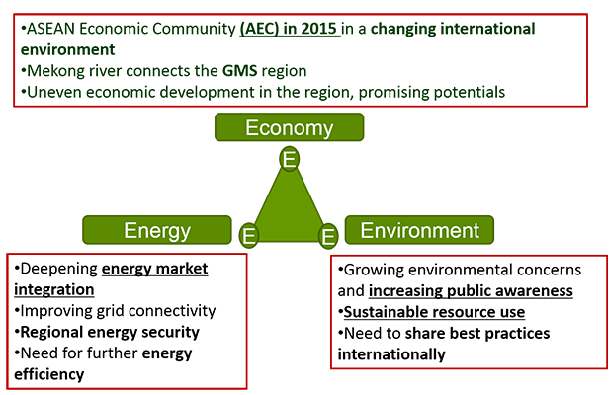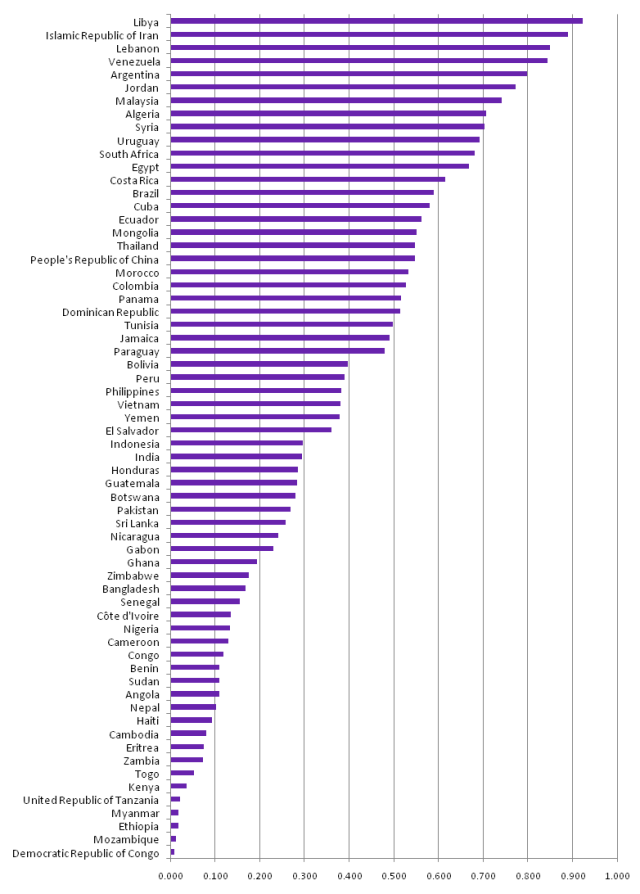Energy Policy in Lao PDR and Myanmar: Issues and Implications
PARI-ERIA Joint Energy Research 2012
1. Introduction: The importance of energy issues in the Greater Mekong Subregions (GMS)
While uncertainty remains on the prospects for long-term economic growth in China, potentials for interlinked growth in the Greater Mekong Sub-regions (GMS), which include both China and the ASEAN group, look more promising, and have recently, attracted more attention globally. When it comes to energy and resources, we may identify 3 aspects as being of paramount importance, namely Economic Growth, Energy Security and Environmental Conservation (the 3E triangle shown in Figure1). Given the complex interrelations between the GMS states, clearly a balanced consideration is called for. No one country in the region can attain its 3E goals in isolation and major trade-offs in prioritization will be unavoidable.

Figure 1 3E in the GMS
Cooperation within the GMS and ASEAN is the key here. In 2015, the ASEAN Economic Community (AEC) will be established. Relationships that recognize mutual interdependence regarding energy supply and demand are deepening. For example, the amount of power imported from Lao PDR to Thailand and Vietnam is growing while natural gas exports from Myanmar have been crucial in sustaining the Thai economy (Figure2).

Figure 2 Energy supply/demand in ASEAN
With the establishment of AEC, we can expect regional economic integration within the GMS to be led by the most economically developed country in the region, namely Thailand. Seen in relation to regional economic and energy relationships, local energy and resources problems in Lao PDR and Myanmar are such a major concern because they are key exporters to Thailand.
In recent years, foreign direct investment (FDI) has been increasing, not only from Thailand and other ASEAN countries but also from China and India. In this context, there has been progress in the construction of a transnational electricity grid between countries in the region, but there has also been a tendency for domestic electric supply to be underestimated in contracts. In order to incorporate FDI regulation into energy strategy, it is imperative that the governments of Lao PDR and Myanmar promote integration between related ministries. Such integration should be all the more effective when coupled with a multilayered “Regional energy / resources governance” strategy.
2. Energy Efficiency: Lao PDR
In Lao PDR, the energy-related ministries have already been integrated into the Ministry of Energy and Mines (MEM). However, inclusive development plans are not well formulated in the MEM's strategy. To rectify this, we have been working to develop a plan that would encompass both the supply and demand sides.
As a first step, we set out to develop a technology roadmap. To this end, we conducted a technology assessment that focused on energy supply technology, such as cutting-edge energy generation systems and transmission lines. Based on a series of stakeholder meetings, we developed three scenarios (poverty reduction, industry creation, and regional integration), drew up a technology roadmap for each scenario, and calculated what the impact of deploying innovative technology might be. Then, we drew up policy recommendations. The process of creating scenarios is critical in identifying policy alternatives.
Second, since relevant statistical data regarding the demand side are still lacking for Lao PDR, we conducted a survey in collaboration with Chulalongkorn University and the National University of Lao to estimate the country's energy efficiency potential. The survey focused on 48 electrical appliances in a sample size of 600 households. The specific research items were ownership of appliances, income level, and family structure, among others. This survey offers insight to policy makers regarding the feasibility of standards and labeling in the country.
The following statistical analyses were conducted. In accordance with the ownership and penetration rate, independent factors such as income level and the number of households were identified. The results showed a strong correlation between the number of households that own an AC and a LED/LCD TV and household income level. In addition, a strong correlation was observed between family structure and the number of households that own refrigerators and a CRT TV.
Recommendations
The implications for an energy supply policy incorporating inclusive development plans are as follows: 1) thermal energy should be introduced in order to end reliance on the current hydro-dependent energy system, 2) hydroelectric dam development should be in line with integrated river basin management, 3) a decentralized energy system should be implemented to alleviate absolute poverty, 4) the price structure between urban and rural regions should be reexamined based on the current gap between these areas, and 5) capacity development in utilities should be undertaken with regard to the huge regional market based on an improved capacity to estimate demand, and proper management against power loss and theft.
In addition, the demand side recommendations are as follows: 1) a comprehensive dataset on demand should be developed so that analysis can be conducted and appropriate measures suggested 2) capacity development should be undertaken to analyze the data set to achieve improved energy systems, and 3) best practices regarding energy efficiency should be shared among the members of ASEAN.
3. Rural Energy Access: Myanmar
In Myanmar, the primary energy supply per capita was 0.32 tonnes of oil equivalent (toe) in 2007, 8% of the supply in Japan. In Myanmar's energy supply, oil accounts for 10% and natural gas for 20%, while biomass is no less than 70%. On the other hand, in its power generation system, hydropower generation accounts for 80% of output. The country exports power from the Shweli dam near the Chinese border to Yunnan province. In addition to exporting gas to Thailand, Myanmar is about to start operation of a massive gas pipeline to China. Thus, the country is a key energy supplier in the region.
Notwithstanding that Myanmar has rich energy resources within its territory, widespread lack of access to modern energy services, particularly in rural areas, means that energy poverty is a very serious problem. Myanmar has been ranked almost at the bottom in the Energy Development Index by the International Energy Agency (IEA) (Figure 3). This result is largely attributed to low energy access in Myanmar's peripheral regions. Despite this paradox of rich resources on the one hand and and poor access to energy on the other, the country should be able to achieve economic development with the implementation of the regional economic integration goals of the ASEAN Economic Community (AEC) on the basis of its solid energy systems.
Myanmar can employ three strategies to improve energy access: 1) expanding the existing grid systems, 2) crafting win-win incentive mechanisms with neighboring countries and investors, especially for border regions, and 3) effectively utilizing local resources in off-grid regions. To examine these strategies, we must conduct grid simulations, fieldwork, and actor analysis.
Recommendations
Above all, the integration of energy-related ministries is a prerequisite to effectively implementing these three strategies. Also, as part of the inclusive development plan, the country should abolish subsidies in the energy sector, review its current tariff structure, and take appropriate steps toward privatizing utilities. Finally, there should be transparency in policy making.

Figure 3 Energy Development Index
Source: IEA (International Energy Agency), World Energy Outlook 2011, Paris, France, 2011
Related Links
Technology Assessment Research Demonstration Project/ERIA Energy Research in East Asia


